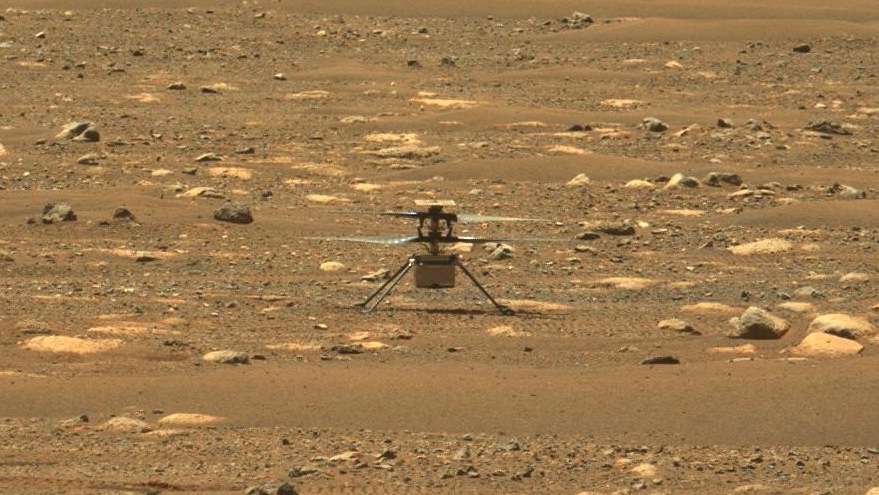WASHINGTON — The successful flight of NASA’s Ingenuity helicopter on Mars paves the way for its use on future missions, agency officials said, but exactly when and how remain to be determined.
At a press conference April 19, project officials said Ingenuity’s first flight, also the first powered flight by an aircraft on another world, opened the door to using similar vehicles in future exploration of the planet.
“What the Ingenuity team has done is given us the third dimension,” said Michael Watkins, director of the Jet Propulsion Laboratory, where Ingenuity was developed. “They’ve freed us from the surface now, forever, in planetary exploration.”
Ingenuity performed well in the 39-second flight, rising to an altitude of three meters, making a roughly one-quarter turn, then descending to a safe landing. “This flight was all about proving that it is possible to fly on Mars,” said Håvard Grip, chief pilot for Ingenuity at JPL. “From everything we’ve seen so far, it was a flawless flight.”
The project team is already preparing for a second flight, tentatively scheduled for April 22. On that flight Ingenuity will fly to an altitude of five meters, then translate, or move sideways, two meters, then go back two meters and land where it took off from. A third flight will be similar, but with the helicopter translating 50 meters out and back.
If Ingenuity performs those flights successfully, the project will carry out two more flights, but the flight plan for those isn’t decided yet. “We still have a little bit of team discussion,” said Grip, based on what happens on the next two flights. “In general terms, what we’re talking about is going higher, going further, going faster; stretching the capabilities of the helicopter in those ways.”
“We will be pushing the envelope,” added MiMi Aung, project director for Ingenuity. “As we succeed in certain lateral flights, we’re going to go further and faster, especially towards the end of the experimental window.”
She said that those later flights may push Ingenuity to the point where it crashes. “The flight today perfectly matched what we were predicting, but we want to push,” she said. “Ultimately, we expect the helicopter will meet its limit, but that information is extremely important. This is a pathfinder.”
The Mars 2020 mission allocated one month to tests of Ingenuity, a time frame that started when the helicopter was released from the rover. Aung said that she was optimistic that the project could get the four remaining flights in over the next two weeks.
In the briefing, project officials compared Ingenuity to Sojourner, the small rover flown on the Mars Pathfinder mission that landed in 1997 and demonstrated the importance of mobility in planetary exploration. “Now those rovers have become Curiosity and our latest, Perseverance, driving tens of miles on the surface and going to the best places for scientific discovery,” Watkins said.
Bob Balaram, the chief engineer for Ingenuity, believed the 1.8-kilogram helicopter could be scaled up. “The fundamental dynamics of these vehicles do scale up to fairly reasonable sizes,” he said. He envisioned helicopters weighing 25 to 30 kilograms that could carry 4 kilograms of science payloads. “That would be a good sweet spot for the next-generation design.”
However, when a larger version of Ingenuity might fly on Mars isn’t clear. NASA’s Mars exploration program is focused primarily on Mars sample return for the next decade with the Perseverance rover caching samples that two later missions, developed in cooperation with ESA, will collect and return to Earth. The only other major Mars mission NASA is currently working on is the Mars Ice Mapper orbiter, scheduled for launch no earlier than 2026.
“I don’t know” when the next helicopter will fly on Mars, said Thomas Zurbuchen, NASA associate administrator for science. “What I’m really interested in, frankly, is the science community’s ideas about how to turn this into a science machine.”
Later in the briefing, he appeared to rule out including a helicopter on the next lander mission, which will collect the samples Perseverance caches and launches them into orbit. “We need to keep it as streamlined as possible. There’s a lot of things we could be adding to this,” he said of that lander. “The campaign we have in front of us is very much focused exactly one key objective, and that is to bring the samples back to Earth.”
Most of the emphasis at the briefing, though, was to discuss the successful first flight of Ingenuity, which attracted worldwide attention. In Washington, White House press secretary Jen Psaki mentioned the flight at her daily briefing. “Today, we congratulate the men and women of NASA and the Jet Propulsion Laboratory for yet again making history in outer space,” she said. “This brief flight now paves the way for more extensive exploration down the road.”
Today, President Biden joined NASA as the Ingenuity Mars Helicopter took off from the surface of Mars. In a historic feat, the helicopter became the first aircraft to fly on a planet beyond Earth. pic.twitter.com/rYFuVcmzbF
— The White House (@WhiteHouse) April 19, 2021
Later, the White House released a photo of President Joe Biden, seated in a studio with a model of Ingenuity, talking by video with the Ingenuity project team. “Today, President Biden joined NASA as the Ingenuity Mars Helicopter took off from the surface of Mars,” the White House tweeted, but did not disclose additional details of the conversation.
There was also, for the project team itself, a chance to finally enjoy success after years of work. “This is the first day in our six, seven years of effort that we feel a license to celebrate,” Aung said. “We have never allowed ourselves to celebrate fully. Yes, we will be celebrating, 100%.”
